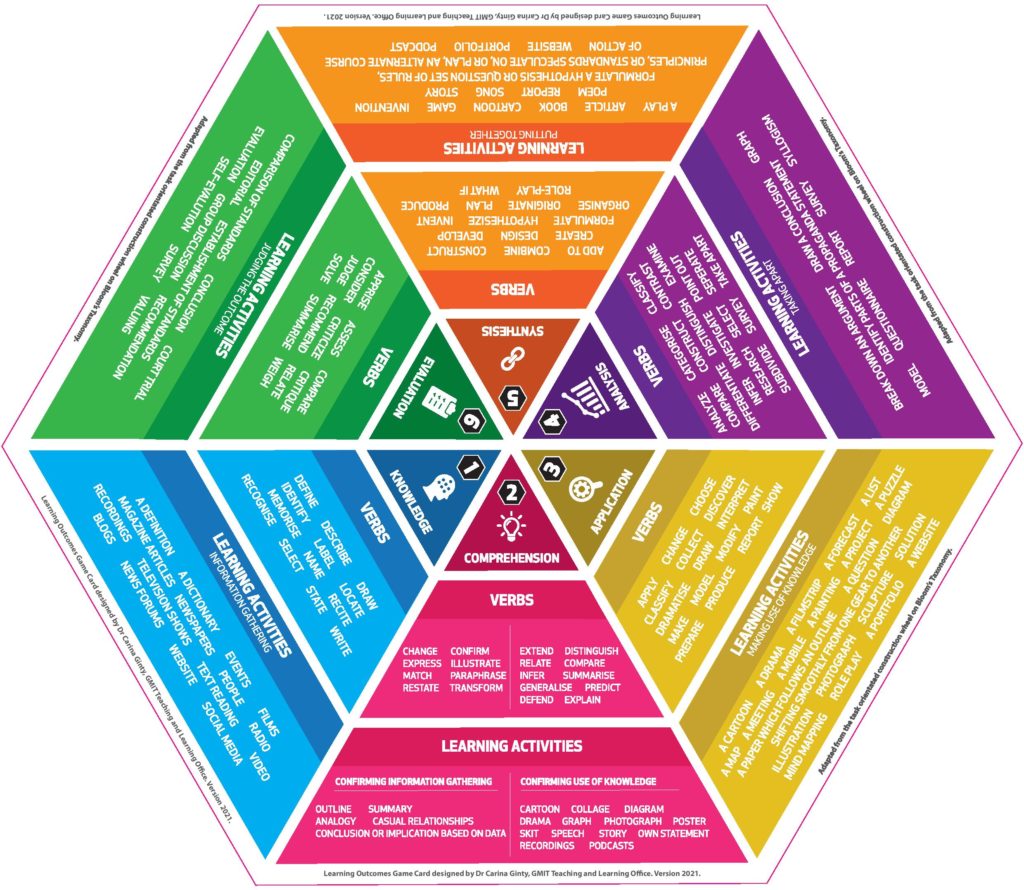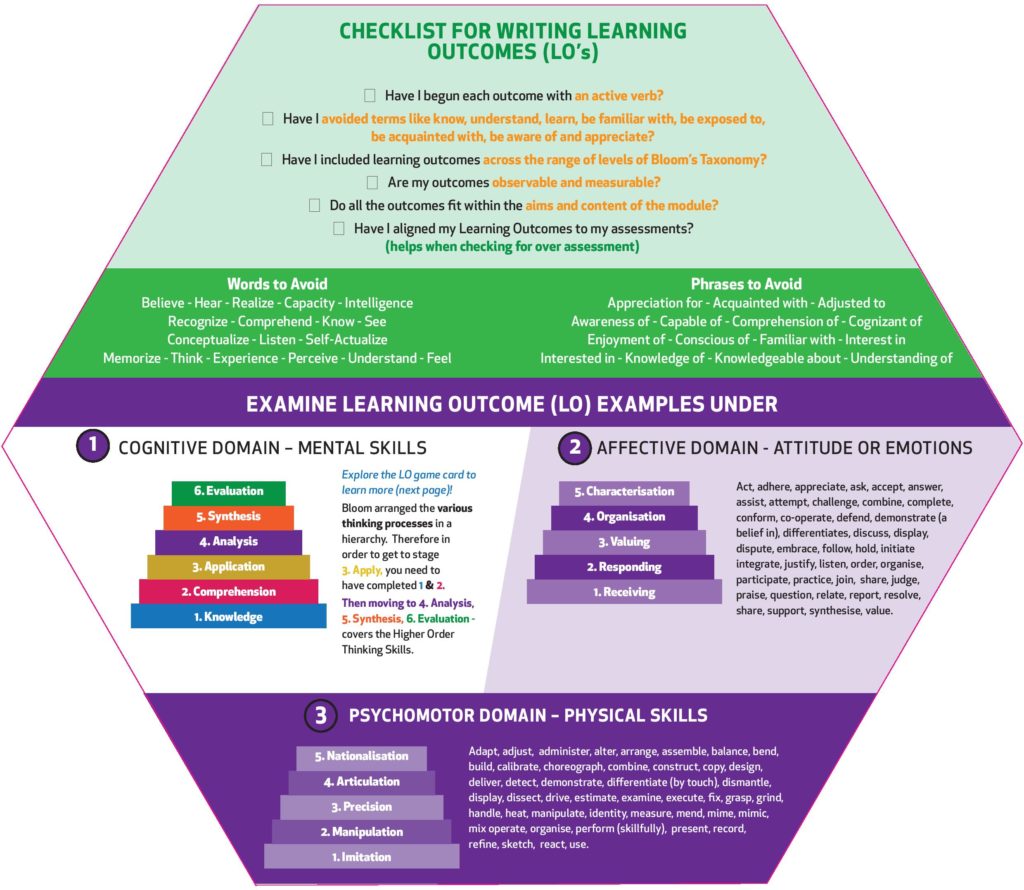Home » Administration » Academic Affairs and Registrar » UDL » Applying UDL » Course Planning
Course Planning
UDL is meant to be considered in the design stage. This is where student variability and potentail barriers can be considered and planned for proactively. In this section, you will see how a course designed following the UDL guidelines can empower learners.
Constructive alignment involves ensuring that learning activities, teaching methods, and assessments are aligned with the learning objectives (Biggs, 1999). When done well, the learning environment will be designed in such a way that students are able to construct their own meaning from the learning.
Using Principles of Constructive Alignment:
· Start by carefully aligning teaching and learning activities and assessments
· These activities should support the students to fulfil learning objectives
· The role of the student (major):
o Students use the activities to construct their knowledge and achieve desired outcomes
· The role of the teacher (minor)
o To design a learning environment that is challenging, encourages taking academic risks, and supports well-being.
Biggs, J. (1999). Teaching for Quality Learning at University. Buckingham: SRHE/OU Press.
Bloom’s Taxonomy is a framework for categorizing educational goals and objectives, which was developed by Benjamin Bloom and a group of educational psychologists in the 1950s. It consists of six levels, each representing a different level of complexity in learning. Learning outcomes should scaffold learning up through these levels with the goal being higher-order tasks. Here are the six levels, along with some example verbs that might be used to describe learning objectives at each level:
Remembering: This level involves recalling information that has been previously learned, without necessarily understanding or interpreting it.
- Example verbs: list, define, identify, memorize, repeat, recite, recall.
Understanding: This level involves comprehending the meaning of information, and being able to explain it in one’s own words.
- Example verbs: explain, describe, summarize, illustrate, classify, discuss, predict.
Applying: This level involves using previously learned information in a new or different context, such as solving a problem or performing a task.
- Example verbs: solve, apply, demonstrate, illustrate, use, show, relate.
Analyzing: This level involves breaking down information into its component parts and understanding how those parts relate to each other.
- Example verbs: analyze, compare, contrast, differentiate, categorize, deconstruct, examine.
Evaluating: This level involves making judgments about the quality, value, or effectiveness of something, based on a set of criteria.
- Example verbs: evaluate, judge, appraise, critique, assess, argue, defend.
Creating: This level involves generating new ideas or products based on existing knowledge or understanding.
- Example verbs: create, design, invent, compose, produce, develop, imagine
Use this reflection activity to find pinch points in your own courses or interactions. This reflective activity can be useful as you consider how to make your course or interaction more inclusive. The goal is to think about the pinch points, or places where students frequently get stuck. This can be in any aspect of your course from communications to assessments, the idea is to find these barriers and consider how implementing UDL can alleviate them
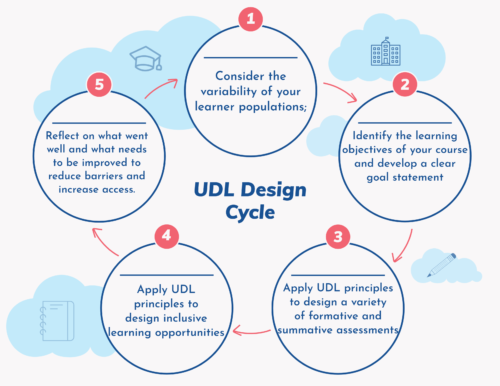 This diagram was adapted from the work of Kavita Rau and Grace Meo (2016). These authors also created the following:
This diagram was adapted from the work of Kavita Rau and Grace Meo (2016). These authors also created the following:
| Lesson component | Questions to ask when considering flexible components and UDL |
|---|---|
| Goals | Based on the academic standard addressed in this lesson, what are the skills and concepts that we want students to master? |
| Assessments | How can students demonstrate achievement of the identified goals in varied ways? |
| Methods | What supports and scaffolds can be used as part of instruction to help students acquire the content and demonstrate what they have learned? |
| Materials | What resources, materials, and tools can be used to provide multiple means to represent and express information and concepts or to engage with content? |
Fink’s Integrated Course Design (2003)
- Step 1: Give careful consideration to a variety of SITUATIONAL FACTORS
- What is the special instructional challenge of this particular course?
- What is expected of the course by students? By the department, the institution, the profession, society at large?
- How does this course fit into the larger curricular context?
- Use the “BACKWARD DESIGN” Process This process starts at the “end” of the learning process and works “back” toward the beginning. Use information about the Situational Factors (Step 1, above), as you make the following key decisions:
- Step 2: Learning Goals
- What do you want students to learn by the end of the course, that will still be with them several years later?
- Think expansively, beyond “understand and remember” kinds of learning.
- Suggestion: Use the taxonomy of “Significant Learning” (Figure 1) as a framework.
- Step 3: Feedback & Assessment Procedures
- What will the students have to do, to demonstrate that they have achieved the learning goals (as identified in Step “A” above)?
- Think about what you can do that will help students learn, as well as give you a basis for issuing a course grade.
- Suggestion: Consider ideas of “Educative Assessment.”
- Step 4: Teaching/Learning Activities
- What would have to happen during the course for students to do well on the Feedback & Assessment activities?
- Think creatively for ways of involving students that will support your more expansive learning goals.
- Suggestion: Use “Active Learning” activities, especially those related to:
- “Rich Learning Experiences” experiences in which students achieve several kinds of significant learning simultaneously
- “In-depth Reflective Dialogue” opportunities for students to think and reflect on what they are learning, how they are learning, and the significance of what they are learning.
- Suggestion: Assemble these activities into an effective instructional strategy, i.e., an interdependent sequence of learning activities, and a coherent course structure.
- Step 5: Make sure that the Key Components are all INTEGRATED
- Check to ensure that the key components (Steps 1-4) are all consistent with, and support each other.
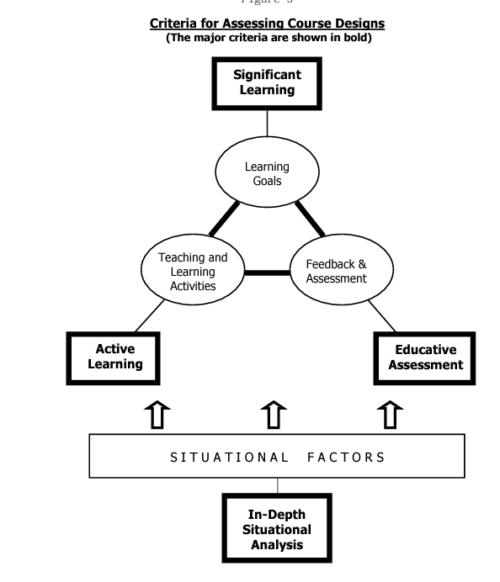
This useful guide by Rose and Meyer, two originators of UDL, outlines many of the major considerations when planning for UDL implementation
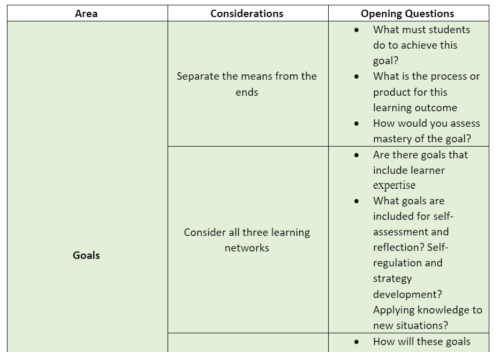
This useful tool helps organize and integrate the UDL Guidelines into the lesson planning process. It helps educators reflect on student variability, barriers, and pinch points as they move through their lesson planning.
